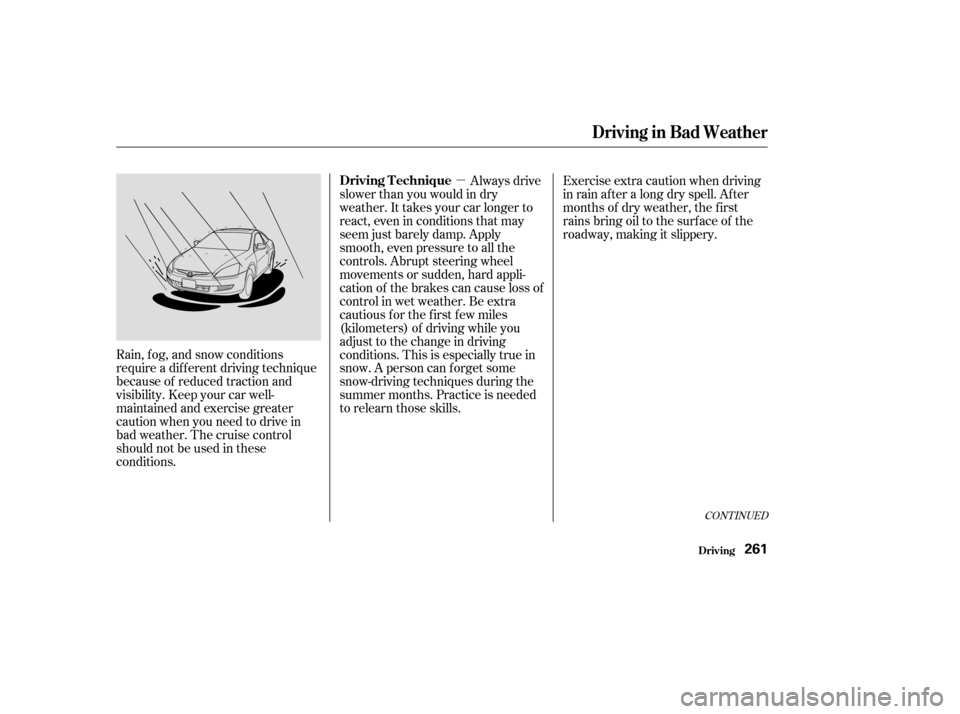Page 234 of 429

A cold engine uses more f uel than a
warm engine. It is not necessary to
‘‘warm-up’’ a cold engine by letting it
idle f or a long time. You can drive
away in about a minute, no matter
how cold it is outside. The engine
will warm up f aster, and you get
better f uel economy. To cut down on
the number of ‘‘cold starts,’’ try to
combine several short trips into one.
You can improve f uel economy by
driving moderately. Rapid acceler-
ation, abrupt cornering, and hard
braking use more f uel.
Always drive in the highest gear that
allows the engine to run and acceler-
ate smoothly.
The air conditioning puts an extra
load on the engine which makes it
usemorefuel.Turnoff theA/Cto
cut down on air conditioning use.
Use the f low-through ventilation
when the outside air temperature is
moderate.
The condition of your car and your
driving habits are the two most
important things that affect the fuel
mileage you get.
Always maintain your car according
to the maintenance schedule. This
will keep it in top operating condition.
Depending on traf f ic conditions, try
to maintain a constant speed. Every
time you slow down and speed up,
your car uses extra f uel. Use the
cruise control, when appropriate, to
increase f uel economy.
An important part of that mainte-
nance is the
(see page ). For
example, an underinf lated tire
causes more ‘‘rolling resistance,’’
which uses f uel. It also wears out
f aster, so check the tire pressure at
least monthly.
In winter, the build-up of snow on
your car’s underside adds weight and
rolling resistance. Frequent cleaning
helps your f uel mileage and reduces
thechanceof corrosion. 291 Driving Habits
Owner Maintenance
Checks Car Condition
Fuel Economy
Bef ore Driving231
Page 247 of 429
Drive in the highest gear that lets
the engine run and accelerate
smoothly. This will give you the best
f uel economy and ef f ective emis-
sions control. The f ollowing shif t
points are recommended:If you exceed the maximum speed
f or the gear you are in, the engine
speed will enter into the tachometer’s
red zone. If this occurs, you may f eel
the engine cut in and out. This is
caused by a limiter in the engine’s
computer controls. The engine will
run normally when you reduce the
RPM below the red zone.
Bef ore downshif ting, make sure the
engine will not go into the
tachometer’s red zone.
Shif t up
1st to 2nd
2nd to 3rd 3rd to 4th4th to 5th Normal acceleration
15 mph (25 km/h)
25 mph (40 km/h)
40 mph (65 km/h)
50 mph (80 km/h)
Shif t up
1st to 2nd
2nd to 3rd 3rd to 4th4th to 5th Cruise acceleration
7mph(11km/h)
22 mph (35 km/h)
33 mph (53 km/h)
48 mph (77 km/h)
Driving
Recommended Shif t Points Engine Speed L imiter
5-speed Manual T ransmission
244
Page 264 of 429

�µ
CONT INUED
Rain, f og, and snow conditions
require a dif f erent driving technique
because of reduced traction and
visibility. Keep your car well-
maintained and exercise greater
caution when you need to drive in
bad weather. The cruise control
should not be used in these
conditions.Always drive
slower than you would in dry
weather. It takes your car longer to
react, even in conditions that may
seem just barely damp. Apply
smooth, even pressure to all the
controls. Abrupt steering wheel
movements or sudden, hard appli-
cation of the brakes can cause loss of
control in wet weather. Be extra
cautious f or the f irst f ew miles
(kilometers) of driving while you
adjust to the change in driving
conditions. This is especially true in
snow. A person can f orget some
snow-driving techniques during the
summer months. Practice is needed
to relearn those skills. Exercise extra caution when driving
in rain af ter a long dry spell. Af ter
months of dry weather, the f irst
rains bring oil to the surf ace of the
roadway, making it slippery.
Driving in Bad Weather
Driving
Driving T echnique
261
Page 383 of 429
By eliminating as much of the
electrical load as possible, you can
drive several miles (kilometers)
before the battery is too discharged
to keep the engine running. Drive to
a service station or garage where
you can get technical assistance.
This indicator should come on when
the ignition switch is ON (II), and go
out af ter the engine starts. If it
comes on brightly when the engine
is running, it indicates that the
charging system has stopped
charging the battery. Immediately turn of f all electrical
accessories:radio,heater,A/C,
climate control, rear def ogger, cruise
control, etc. Try not to use other
electrically-operated controls such as
the power windows. Keep the engine
running and take extra care not to
stall it. Starting the engine will
discharge the battery rapidly.
T aking Care of t he Unexpect ed
Charging System Indicator
380
CHARGING SYSTEM INDICATOR
Page 412 of 429
Then drive in city/suburban
traffic for at least 10 minutes.
When traf f ic conditions allow, let
the car coast for several seconds
without using the accelerator
pedal or the brake pedal.
If the testing f acility determines the
readiness codes are still not set, see
your Honda dealer.
Select a nearby lightly traveled
major highway where you can
maintain a speed of 50 to 60 mph
(80to97km/h)foratleast20
minutes. Drive on the highway in
D (A/T) or 5th/6th (M/T). Do
notusethecruisecontrol.When
traffic allows, drive for 90 seconds
without moving the accelerator
pedal. (Vehicle speed may vary
slightly; this is okay.) If you cannot
do this f or a continuous 90
seconds because of traf f ic
conditions, drive f or at least 30
seconds, then repeat it two more
times (for a total of 90 seconds).
St at e Emissions T est ing
T echnical Inf ormation409
Page 421 of 429

�Î
...................
Capacities Chart . 396,398
.............
Carbon Monoxide Hazard . 56
......................................
Cargo Net .237
.............................
Carrying Cargo .234
..............
CAUTION, Explanation of . ii
..................
CD Changer . 156,173,196
.......................................
CD Player .154
........................
CD Pocket, Center .113
........................
Certif ication Label .394
............................................
Chains .338
....................
Changing a Flat Tire .365
............
Changing Engine Coolant . 301
Changing Oil ........................................
How to .296
.............................
When to .276, 284
...
Charging System Indicator . 62,380
............
Checklist, Bef ore Driving . 240
.......................................
Child Seats .26
.........................................
LATCH .43
..........
Tether Anchorage Points . 42
...................................
Cleaner, Air .316
Cleaning ....................
Aluminum Wheels .357
...................................
Carpeting .358 ......................................
Exterior .356
.........................................
Fabric .359
.......................................
Interior .358
.......................................
Leather .359
...................................
Seat Belts .359
...........................................
Vinyl .359
......................................
Window .360
...............
Climate Control System . 129
.........
Clock, Setting the . 153,171,193
...................................
Clutch Fluid .314
........................
CO in the Exhaust .406
...................................
Coin Pocket .113
............
Cold Weather, Starting in . 242
..............................
Compact Spare .364
.................
Console Compartment . 111
...............
Consumer Inf ormation . 412
.............
Controls, Instruments and . 59
Coolant ........................................
Adding .299
....................................
Checking .230
.........................
Proper Solution .299
...................
Temperature Gauge . 70
....................
Corrosion Protection .361
Crankcase Emissions Control ........................................
System .405
............
Cruise Control Operation . 214..........
Customer Relations Of f ice . 412
................
DANGER, Explanation of . ii
...................................
Dashboard .2, 60
................
Daytime Running Lights . 76
............
Def ects, Reporting Saf ety . 414
................
Def ogger, Rear Window . 79
Defrosting the ....................
Windows .127, 136,144
............................
Dimensions .396, 398
...............
Dimming the Headlights . 74
Dipstick .
Automatic Transmission . 307,308
..................................
Engine Oil .228
..........................
Directional Signals .77
........
Disc Brake Wear Indicators . 254
.....................
Disposal of Used Oil .298
Doors ..............
Locking and Unlocking . 86
......................
Power Door Locks .86
..........
DOT Tire Quality Grading . 400
Downshif ting, Manual .....................
Transmission .243, 245
.......................................
Drive Belt .332
Index
C
D
II